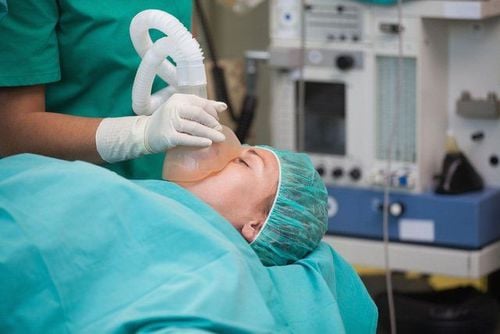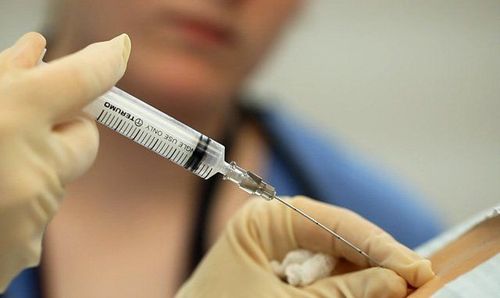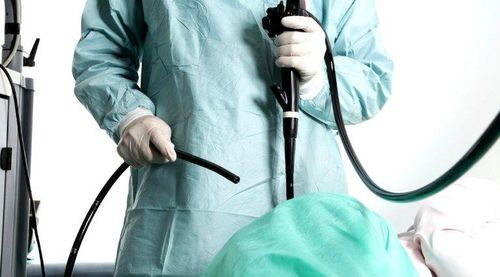This is an automatically translated article.
The article was professionally consulted by Specialist Doctor I Nguyen Duc Thong - Anesthesiologist - General Surgery Department - Vinmec Danang International Hospital.Respiratory anesthesia is a method of using anesthetics through inhalation to bring the patient into a state of loss of consciousness but still maintain vital functions before surgery. Inhalational anesthesia is indicated in some surgeries or analgesia in some cases.
1. What is respiratory anesthesia?
Respiratory anesthesia is a method of using anesthetics through inhalation for the purpose of temporarily losing the patient's consciousness, this is the first anesthetic method used to anesthetize patients; Anesthesia (TM) is in the vapor state (gaseous form), if the IV is in liquid form, it must be evaporated and turned into a gaseous state before entering the patient through a dedicated breathing machine.Stages of respiratory anesthesia:
Pre-anesthesia : The period before anesthesia. Induction of anesthesia: When starting the amount of anesthetic enough to bring the patient to a state of anesthesia. Maintenance: During surgery, a dose of anesthetic is required to maintain the state of anesthesia. Adjust the anesthetic concentration according to the patient's response through adjusting the evaporator and air flow into the patient's lungs. Anesthesia release: Reduce dose and stop using anesthetic, anesthetic will be discharged until the amount of drug is no longer to have an anesthetic effect, the patient will gradually wake up. When the patient inhales the anesthetic drugs from the outside go through the nose, mouth, larynx, trachea into the alveoli. When the anesthetic enters the alveoli because the anesthetic concentration in the alveoli is higher than in the blood, the anesthetic will be absorbed into the blood and travel to the organs including the brain. When the anesthetic reaches the right concentration in the brain, the patient will lose consciousness.
After that, when the anesthetic is no longer needed, the anesthetic is not supplied to the blood muscle through the respiratory tract, the anesthetic will escape through the respiratory tract mainly because at this time, the anesthetic concentration in the blood is higher than outside. , when the anesthetic concentration drops to a certain level, the patient will wake up.
Mechanism of action of inhalation anesthetics: When inhaled anesthetics are introduced into the organism, they have the ability to temporarily inhibit the central nervous system with properties such as sedation, analgesia and analgesia. soft muscle.
During respiratory anesthesia, anesthetic drugs are maintained at an appropriate concentration into the patient's airway, until the anesthetic is released, reduce the dose of anesthetic in the breath, the patient will wake up gradually.
Currently, when using respiratory anesthetics, it is used in combination with drugs such as sedatives, muscle relaxants, etc., which reduces the dose of each drug but increases the anesthetic effect, while still ensuring safety. .
During respiratory anaesthesia, the patient can breathe on his own or be subject to controlled breathing through a nasal mask, laryngeal mask, or endotracheal tube.
During the process of anesthesia, the patient may have some side effects caused by the anesthetic drug, so the patient is monitored with clinical signs and parameters on the monitor to adjust the level of anesthesia. anesthesia or manage complications.
2. Inhalation anesthetic drugs
Anesthetics are substances that, when put into the body at a certain dose, will temporarily lose consciousness of the patient, but still maintain vital functions such as circulatory function, respiratory function, metabolism.. .General anesthetics are toxic, so each drug has its own maximum dose. Because if the dose is too low, it will not be enough to induce the patient, and if the dose is too high, the patient will be toxic.Currently, there are 2 types of anesthetics used for respiratory anesthesia including:
Gaseous anesthetics: nitrous oxide (also known as laughing gas) is not common in Vietnam. Volatile liquid anesthetics: Halogenated drugs include: Foran (slightly used isoflurane), new drugs: Sevoran (Sevoflurane), Desfluran have better effects (rapid awakening, less cardiovascular effects, less hepatotoxicity) , kidney) are widely used in Vinmec medical facilities.
2.1 Nitrogen oxide anesthetics
It is a gaseous, colorless, non-explosive anesthetic.Indications:
Pain relief when transporting burn and dental patients. Surgical anesthesia when combined with other anesthetics in major and prolonged surgery. Contraindications:
Absolutely: traumatic brain injury; loss of consciousness; pneumothorax. Relative: intestinal obstruction, shock, bleeding, hypoxia, heart failure, coronary artery disease, sickle cell disease. Mechanism of action of nitrous oxide: General anesthesia via drug interaction with CNS membranes; however, the exact mechanism is unclear. This drug is absorbed into the bloodstream more quickly than halogen drugs and is eliminated through the breath.
Effects of drugs:
Central nervous system: Has analgesic, anesthetic effect, if high concentration causes forgetfulness. Cardiovascular system: Increased pulmonary vascular resistance, decreased myocardial function and increased sympathetic system, mild cold, slight increase in heart rate. Respiratory system: Mild respiratory depression. Undesirable effects
Lack of oxygen when the concentration is over 70%. May cause nausea and vomiting.

Thuốc gây mê nitơ oxit có thể gây buồn nôn và nôn
2.2 Halogen anesthetics
Halogen drugs have an unclear mechanism of action, this group of drugs is absorbed through the respiratory tract and mainly excreted through the respiratory tract 95% and 5% by the kidneys, metabolized in the liver. Some commonly used drugs in this group include:Isoflurane : A colorless, non-explosive drug.
Indicated in case: Maintenance of anesthesia in surgery for adults, children and outpatient anesthesia.
Contraindications:
Absolute contraindications: Personal or family history of malignant hyperthermia, halogen sensitivity, porphyria Relative: Pregnant women, do not use induction of anesthesia in children under two years of age. Effects:
On the central nervous system: Loss of consciousness of the patient, has no analgesic effect, inhibits the respiratory center, vasomotor and temperature, has little effect on brain electricity. Increases intracranial pressure less than other halogens, lowers brain metabolic rate than other halogens, reduces brain cell oxygen consumption. Cardiovascular: Slightly reduces myocardial contractility, increases heart rate. Blood pressure varies with dose, coronary blood flow is moderately reduced, myocardial oxygen consumption decreases. On respiration: Decreases tidal volume and respiratory rate according to the dose of the drug, dilates the bronchi. Other effects: Little effect on the liver, causing muscle relaxation, reducing intraocular pressure. Undesirable effects:
May cause glottis edema. Causes nausea, vomiting. Malignant hyperthermia. Sevorane
Indications: Anesthesia in surgery and maintenance of anesthesia in surgery for adults and children, has an advantage in neurosurgery and outpatient anesthesia.
Contraindications:
Absolute: Personal or family history of malignant hyperthermia., sensitivity to halogens, disorders of porphyria Relative: Pregnant women (under cesarean section), women breastfeeding women. Effects:
On the central nervous system: Causes loss of consciousness, has no analgesic effect, inhibits the respiratory, vasomotor and temperature centers. little effect on the EEG. Causes less increase in intracranial pressure than other halogen drugs, reducing cerebral oxygen consumption. Cardiovascular: Slightly reduces myocardial contractility, stabilizes heart rate, stabilizes cardiac output. Blood pressure is affected by dose. Coronary blood flow is moderately reduced, coronary resistance is stabilized, myocardial oxygen consumption is reduced. On respiration: Decreased tidal volume and respiratory rate depending on the dose, causing bronchodilator. Other effects: No effect on liver, muscle relaxant, decrease intraocular pressure.

Tăng thân nhiệt ác tính là tác dụng phụ của thuốc mê
Undesirable effects:
May cause glottis edema. Nausea, vomiting. Malignant hyperthermia. Inhalation anesthesia is used to temporarily lose consciousness of the patient, over the time of research and use of some anesthetic drugs that are no longer used due to high kinetics and poor anesthetic ability. The anesthetic drugs are all toxic, so the use of which is appropriate for each subject and the dose used is enough to cause anesthesia but minimized so as not to cause toxicity.
Vinmec International General Hospital is one of the hospitals that not only ensures professional quality with a team of leading medical doctors, modern equipment and technology, but also stands out for its examination and consultation services. comprehensive and professional medical consultation and treatment; civilized, polite, safe and sterile medical examination and treatment space.
Doctor Duc Thong has 14 years of experience in the field of Anesthesia. Especially, with 12 years working at the Department of Anesthesiology and Resuscitation at C Da Nang Hospital, Dr. Thong has extensive experience in the field of Anesthesia and resuscitation for elderly patients with many comorbidities and serious illnesses. surgery; helping many heavy and complicated surgeries to be successful. Currently, he is an anesthesiologist at the Department of General Surgery - Vinmec Da Nang International General Hospital.
Customers can directly go to Vinmec Health system nationwide to visit or contact the hotline here for support.














